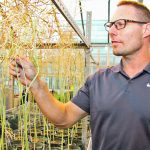Agriculture Canada spent 27 per cent of its science budget on efforts to reduce greenhouse gas emissions last year
UPDATED: January 8, 2025 – 1500 CST – added Ag Canada data/chart – WINNIPEG — Agriculture Canada spent $223 million more on science and innovation in the 2023-24 fiscal year than it did in 2020-21. However, the money wasn’t used to hire new scientists, expand research centres or study innovative technologies such as gene edited […] Read moreTag Archives plant breeding

Cost of access to plant gene banks may increase
Proposed changes to international plant gene sharing treaty could could bring additional costs to researchers, farmers
Glacier FarmMedia – Plant breeders around the globe can freely access plant gene banks for development of new crop varieties under the Treaty on Plant Genetic Resources for Food and Agriculture. Proposed changes at the international level could make access — and future crop research — more costly. Who would pay that cost is not […] Read more
Root rot in research lens
WINNIPEG — Pulse crops breeders have had some success in developing varieties of peas and lentils with genetic resistance to root rot. Researchers from the University of Saskatchewan have developed lines of peas with partial resistance to aphanomyces, a stubborn soil pathogen that causes root rot. “Some promising lines are now in registration trials,” said […] Read more

Pulse sector goes slow on gene editing
WINNIPEG — Canadian pulse growers may have to wait before they can plant gene-edited peas, lentils and chickpeas. Gene editing is a permitted technology in Canada and in India, a critical export market for pulse crops. However, researchers and pulse industry leaders are hesitant to release gene-edited varieties because they’re worried about market acceptance. For […] Read more

Research priorities breed frustration, confusion
WINNIPEG — Last year at harvest time, farmers across western Manitoba and parts of eastern Saskatchewan had a similar reaction. When they looked at yield monitors in their combines, they were surprised at figures of 60 to 75 bushels an acre for spring wheat, despite lack of sufficient moisture during the growing season. Other stories […] Read more

Alberta Grains chair passionate about new role
Group’s first chair identifies lack of moisture and falling commodity prices as two of grain producers’ biggest challenges
The first chair of Alberta Grains is passionate about Alberta’s wheat and barley growers and the fledgling organization she’s been chosen to lead. “I take my role incredibly seriously,” said Tara Sawyer, an Acme-area farmer with five years of experience in positions with the former Alberta wheat and barley commissions. “I don’t take my leadership […] Read more
Research explores plant breeding predictability
Study indicates that the role of background mutations demands greater reassessment when developing new varieties
For about 80,000 years, evolution has shaped cherry-sized tomatoes that first originated in Ecuador. Farming and crop breeding led to bigger, sweeter varieties as they spread in popularity and diversity of uses. Now, CRISPR gene editing can create new mutations with even greater improvements on desired traits. But none of these mutations, whether natural or […] Read more
VIDEO: Genome selection helps find next superstars
In the 2020 Western Hockey League bantam draft, the Regina Pats had the first overall pick. They selected Connor Bedard. It was an easy pick and a good one. Bedard recorded 100 points in the 2021-22 WHL season and 143 points last year. Then, in June, the Chicago Blackhawks selected Bedard with the No. 1 […] Read more

Genomic crop research goes wild
While the vast majority of crops produced in Canada have been introduced from elsewhere, there is a lack of wild type relatives existing in nature for these crops. This is not the case in many other parts of the world where plants used for domesticated food production have wild types that bear genetic similarity. In […] Read more

Canola counts on agronomy, future innovation
Sector is convinced that improved agronomy in the short term and big innovations in the 2030s will push yields higher
In early October, Western Producer reporter Robert Arnason spoke with Curtis Rempel, vice-president of crop production and innovation with the Canola Council of Canada. The topic was canola yield gains over the last two decades and what will drive gains in the future. RA: What happened in the 2000s, which led to significant yield increases […] Read more



